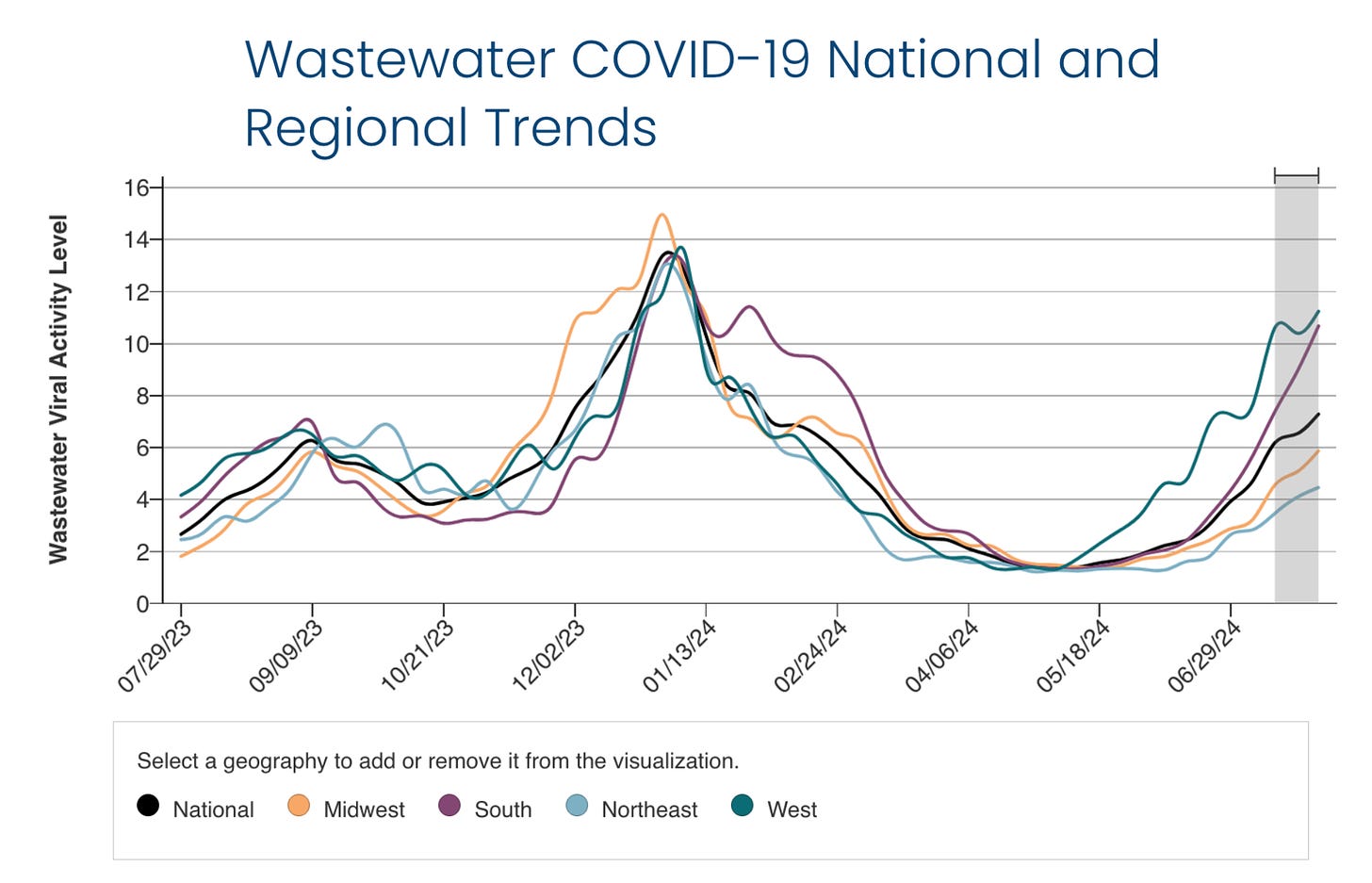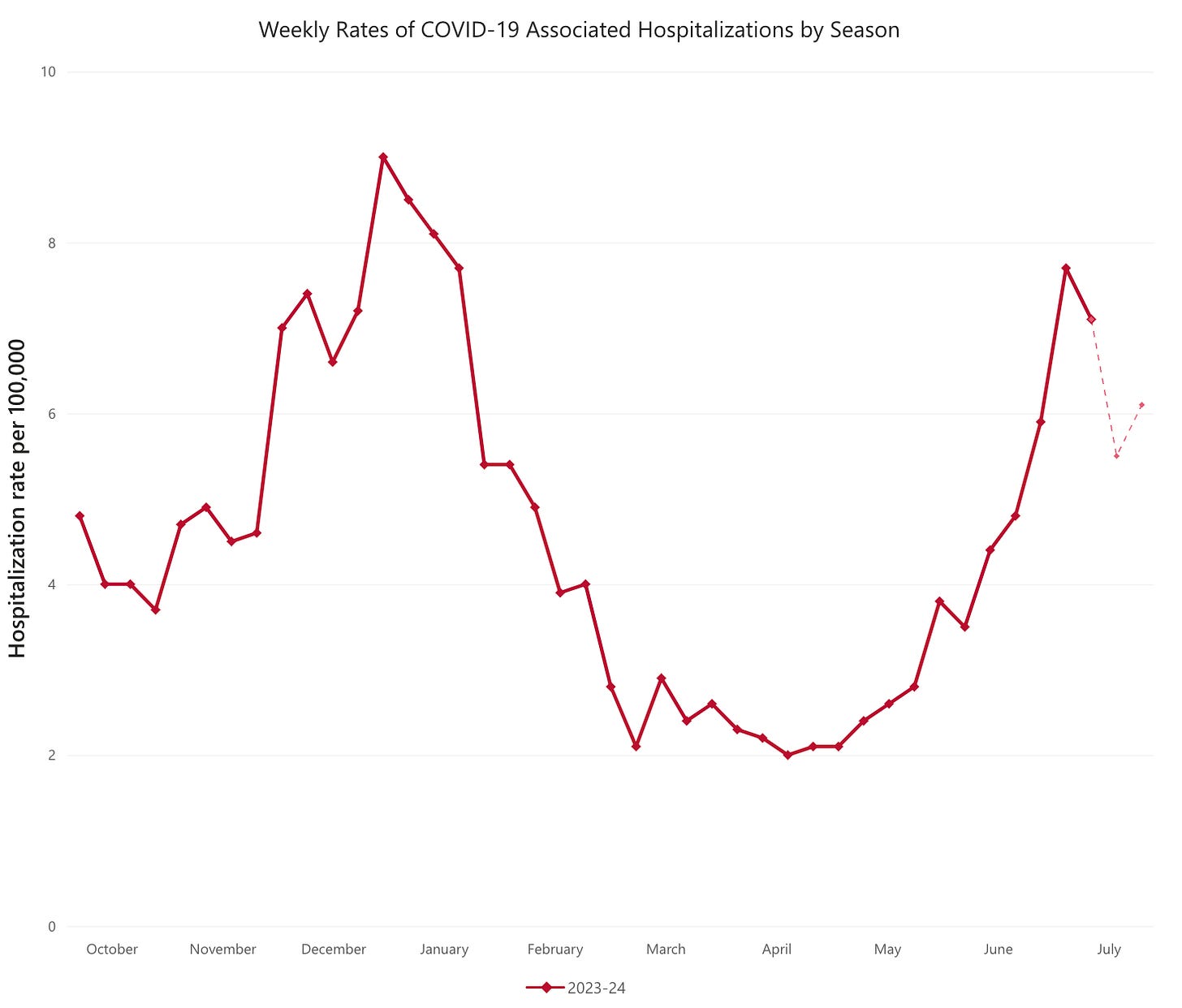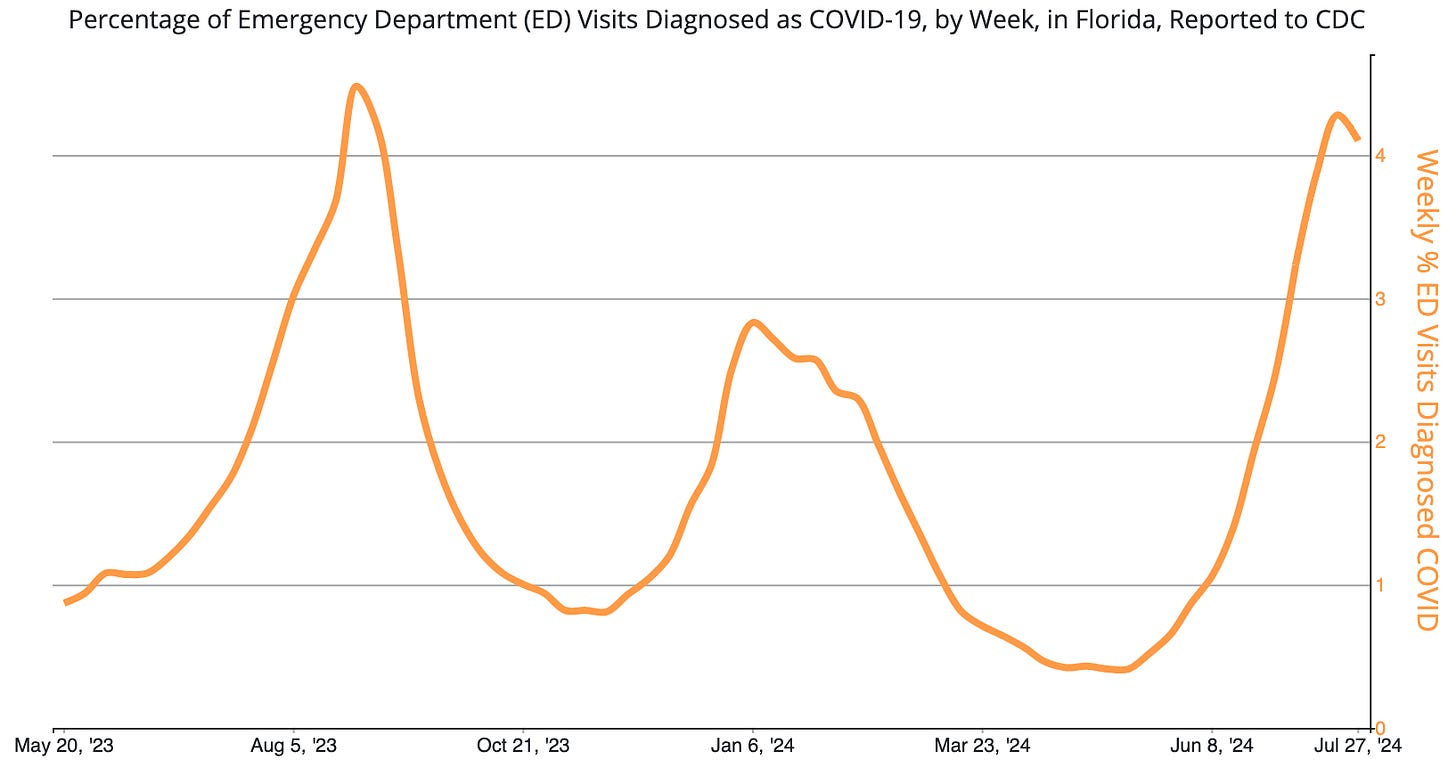Hits: 109
BY DR. CAITLIN RIVERS
ILI
Influenza activity remains minimal, with 1.5% of all outpatient visits nationally due to influenza-like illness. Hospitalizations remain near-zero at 0.1 hospitalizations per 100,000 individuals. As we near the fall, this will start to change, but I am enjoying the break while it lasts.
COVID-19
The summer wave continues. Wastewater activity is high nationally and increased again this past week; it is at levels last seen in January of this year.

Emergency department visits have also increased yet again this past week and now account for 2.2% of all ED visits. This is close to the 2.5% peak of last summer’s wave. Most of the country reported moderate (+10-19%) or substantial (>20%) increases in ED visits this past week.
While hospitalizations declined slightly this past week to 2.8 hospitalizations per 100,000 population, this has limited usefulness as a proxy for severity nationwide, given that we are only receiving hospitalization data from a small number of states and the Covid-19 picture is quite different from state-to-state at the moment.
Western region
The West continues to have the highest wastewater activity in the country at 1.5x the national average, and viral concentration increased again this past week. Levels are the highest they have been since January, and every state in the region except Arizona is reporting high or very high levels of wastewater concentration.
I thought the region might have been peaking, but I’m less certain this week, given that indicators bumped back up.
In California, Covid-19 now accounts for 2.3% of all ED visits (on par with the peak from last summer of 2.4%), and after a couple weeks of moderate declines, hospitalizations in the state increased again, to 6.1 hospitalizations per 100,000. Wastewater activity in the state also increased again this past week, and concentrations are higher than the regional and national averages.

Emergency department visits held steady in most Western states this past week, with moderate increases in Colorado and Oregon. Oregon also saw an increase in hospitalizations (to 3.1 per 100,000), but Colorado held steady (1.9), and New Mexico (2.2) and Utah (1.6) reported slight declines.
Southern region
Wastewater activity has been making a steep ascent in the South, and that pattern continued this past week. The activity is now as high as it was in January, and it has handily surpassed that of last year’s late summer wave.
Some relief may be coming for Florida, where wastewater activity appears to have peaked (it was hit early by this wave), but the same cannot be said for most of the other states in the region.
Emergency department data show that severe illness is also increasing in the region. Nearly every state in the region reported moderate or substantial increases in ED visits. Florida (4.1%), Texas (3.6%), and Louisiana (3.7%) have the highest rates in the region.

Unfortunately, we do not have hospitalization data for the states that appear to be experiencing the greatest surge in cases, so it is challenging to get a true sense of severity. For the states for which we do have data, hospitalizations declined (to 2.5 hospitalizations per 100,000 individuals in Maryland, 2.2 in Tennessee, and to 1.5 in Georgia).
Midwestern region
Although the Midwest continues to fare better than the West or the South, wastewater activity continues to rise in the Midwest and is now greater than that seen in last summer’s wave. Kansas’s wastewater activity caught my eye – it is now higher than anywhere else in the region and greater than the national average.
Severe illness is on the rise as well. Every Midwestern state reported moderate or substantial increases in emergency department visits for Covid-19 (Minnesota and Missouri did not report any data), though rates still remain low overall.
Hospitalizations have increased significantly in Michigan – increasing by over 2 points in the past week, to 3.6 hospitalizations per 100,000 individuals – this is back around where hospitalizations were in March of this year. However, after increasing for the past several weeks, hospitalizations dipped in Minnesota (to 2.4), and held steady in Ohio (at 1.8).
RSV
There are no signs of RSV yet, with wastewater activity and test positivity still very low nationwide (< 3%). But it’s time to start looking out for it, as RSV typically begins to pick up in late summer, and there have been very slight upticks in test positivity the Northeast and the South.
Stomach Bugs
Could it be — some good news about norovirus?! Test positivity this past week dropped to 6.1%, the lowest levels we’ve seen since last November.
First, the good news. The Midwest reported a significant decline in test positivity to 5.3% – this is less than half the average rate in the region of the past 9 months (11.4%). In addition, the West, which had been seeing very high rates the past few weeks, dropped from 15.2% test positivity last week to 7.5% this week. However, given the wide swings that have been occurring in the West, it is too soon to say whether this will last.
Now for the not-so-good news. Things have not yet improved in the South, where test positivity increased again, to 8.3%, which is well above the expected rates for this time of year. The Northeast also reported a slight increase in test positivity, to 4.1%, but this is within the expected range for this time of year.
Food recalls
The following foods are being recalled because they are contaminated. Please check your cupboards and throw out any of these items:
New:
- Fresh guacamole products from Lunds & Byerlys (more info)
Previously reported:
- ! Boar’s Head meats sliced at deli counters (more info)
- A range of SNOWFRUIT branded vegetable, salsa, and herbs sold in clam-shell containers in Kroger and Jay C stores (more info)
- ALB Flavor cinnamon powder, for lead contamination (more info)
- Jalapenos, peppers and green beans sold at ALDI’s in Kentucky, New York, Ohio, Pennsylvania and West Virginia (more info)
- Kenny’s Farmhouse branded St. Jerome’s cheese (more info)
- The previously reported Wier’s Farm recall of whole vegetables and bagged salads has expanded substantially. Items were sold in a number of major retailers, including Wal-Mart and Kroger. (more info)
- Shelled walnuts in 1lb bags provided primarily to food banks, shelters, school lunch systems, and prisons (more info)
- Wiers Farm cucumbers, whole and salad (more info)
- AW Farms hot dogs (more info)
In Other News
Measles
- The Minnesota Department of Health (MDH) confirmed three measles cases in unvaccinated children this week in Anoka, Hennepin, and Ramsey counties, raising concerns about community spread. These cases, confirmed on July 22 and July 24, are not linked and involve two hospitalizations. Minnesota has reported 15 measles cases in 2024, all in unvaccinated children, with over 50% hospitalized.
- A traveler with measles flew from London to Los Angeles International Airport (LAX) and then to Orange County, potentially exposing the public to the disease, health officials reported Wednesday. Individuals in the LAX terminal from 2:30 to 4 p.m. on Friday, July 26 may be at risk of developing measles. Several other locations in the area, including a local emergency department, are also affected. The number of people potentially exposed is unknown.
Other pathogens
- No new human cases of H5N1 were reported in Colorado this week. Last week, there were two clusters totaling 10 cases, all farm workers.
- Alpha-gal syndrome, an allergy to red meat caused by tick bites, is rising in Arkansas, Oklahoma, and Missouri, with a 41% increase in cases reported by the CDC from 2017 to 2022. The lone star tick, prevalent in the southeastern U.S., is the primary vector, injecting alpha-gal (galactose-alpha-1,3-galactose) into humans through its saliva, triggering allergic reactions. Researchers are uncertain why only some people develop this allergy despite widespread tick bites. Milder winters and better reporting contribute to the increased tick population and alpha-gal cases. Preventative measures include avoiding tick bites and eliminating red meat and mammal products from the diet if diagnosed.
- World Health Organization Director-General Tedros Adhanom Ghebreyesus is considering convening the committee that can advise on whether the clade Ib mpox outbreak is a Public Health Emergency of International Concern. It’s the latest indication that the outbreak, first reported in the Democratic Republic of Congo (DRC), is a serious event that merits international attention and support to the responding countries. As a reminder, this outbreak is a different clade than the one responsible for the 2022 outbreak that mostly affected men who have sex with men. DRC is finding a high burden in children, evidence of household and heterosexual transmission, and disseminated rash.
- The Pan American Health Organization has upgraded the risk level of Oropouche fever in the Americas to High due to an increase in cases in South America, because of expansion to new areas, the first-ever reported deaths, and potential vertical transmission linked to fetal death and newborn microcephaly. The spread is attributed to mosquitoes (Culex quinquefasciatus) as well as biting midges (also called no-see-ums). What is unique about this virus compared to dengue, Zika, etc. is that the vectors are thought to be present in much of the United States. (However, no transmission has been found in the U.S. to date.)
- The California Department of Public Health (CDPH) is investigating cases of Valley fever among attendees of the Lightning in a Bottle music festival held from May 22-27, 2024, in Kern County. Five cases have been identified, with three hospitalizations, and more cases are possible. Valley fever, caused by the Coccidioides fungus found in California soil, can lead to respiratory symptoms such as cough, fever, and difficulty breathing.
